Hayedo, charming and mysterious
the Agadía is a typical forest of our mountain area, with humidity and fog. These magnificent forests that emphasize our landscape have suffered a great setback.
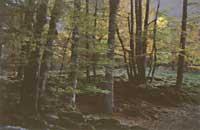
The beech is a forest typical of our mountainous area, accompanied by humidity and fog. These magnificent forests that emphasize our landscape have suffered a great setback. There have been different factors for this: from grazing to planting foreign species (conifers) in many areas. Therefore, the surface of the beech trees has been decreasing.
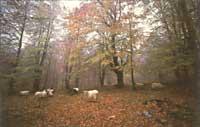
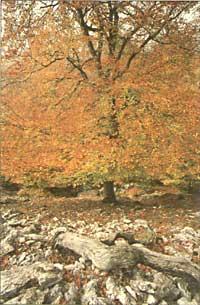
Beech (Fagus sylvatica 2. ), Fagaceae is an intrafamilial species. This family is the most important tree in the temperate region of the northern hemisphere. In both gender and number of species, there is a debate among botanists. Also when dating the oldest genus. There are pallionologists who consider the Fagus the oldest, but there are others who say that the genus Nothofagus (which is divided into Andes, Australia, Asia,...) is as old as this. However, it seems that the Fagaceae originate in Oceania and Indomalaysia and the genus Fagus, which left for Laurasia, arrived in North America (the Fagus frisca, typical fossil of the North American and European Cretaceous).
The species we have among us (Fagus sylvatica) appeared at the end of the Cenozoic in the Palearican area, suffering intense phases of expansion and delay in the Quaternary (due to the glaciations). This endemic European species extends to the west and middle of the continent, situating the northern limit in Scandinavia (parallel 60º). The south, in Sicily (on Mount Etna, parallel 38°).


As for the peninsula, it extends mainly in the North, finding itself as a relic in Ayllon (Cordillera Media).
In Euskal Herria is distributed in all regions where fog and humidity abound. In the south of Navarra we do not see specimens of beech because the climatic conditions are not met. It appears especially in the mountain area, although on several occasions it appears in low altitude valleys.
In general, it can be observed in any type of soil at a distance of between 500 and 1,500 meters if adequate drainage is offered.
Circular crown tree and abundant foliage, can reach a height equal to or above 30 meters. Its bark is smooth, whitish or silver gray.
The eyes of the armpit are reddish and the leaves are formed by numerous nerves. Being oval elliptical, they again have hairy edges and are light green at the beginning, although then they are gradually obscured. Between 4 and 9 cm. and are expired.

Male flowers are usually globose (very abundant) formed by gardeners, accompanied by leaves. They hang from long peduncles of 5-6 cm. Female flowers, on the other hand, are usually single or triple in short hairy peduncles. The fruits are stored in wooden cases. From the outside is scaly and from the inside long hair, open in 4 leaflets. The fruits of the beech are rich in nutrients (fat, starches, etc.). have) and are appreciated by numerous pigs, boars and other wild animals. Blooms in spring and beeches ripen in early autumn.
Beech wood is usually white or light brown, hard, heavy and of uniform fine texture, widely used in the ether. Moreover, it is used in the manufacture of tools (shovel, spoons, etc.) and in the manufacture of barrels, wood for fire and / or for the manufacture of coal being appreciated.
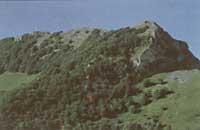
In the Basque Country there is a typical species of the mountain, with important masses that are observed in the mountains that cross from east to west. But the truth is that its potential surface has suffered a great decline. In the Neolithic era they were reduced by grazing and since then wood, coal and planting foreign species also did. It is evident the need to take concrete measures for the conservation and improvement of these wonderful forests. Also, suitable usage criteria.
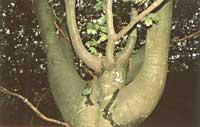
Our beech trees, in general, can be classified into two groups: acidophiles (acidifiers) and eutrophs. However, as the number of rainfall is very high in our area, the soil has undergone a continuous change, predominating acidophilous beech.
Acidophilous beech appears in most soils, except in those of simple limestone. Although the calcareous areas are widespread, the number of rains and the litter have conditioned the oligotrophy of the soil, imposing acidificofilia. Of course, when its soil is sandy only appears acidophile beech. In the Atlantic slope, the beech predominates mainly from 500-600 meters, although at low altitudes, as in the humid slopes, is frequent its appearance. Next to the beech is also the oak or honey.

In the acidophile beech appear different plants, among which are the holly (Ilex aquifolium), the blueberry (Vaccinium myrtillus), the comb fern (Belchum spicant), the forest bitterness (Oxallis acetosella)...
In its day this type of beech encompassed one of the largest areas of our territory, suffering a sharp decline for the aforementioned reasons. However, there are still forests of interest in Gipuzkoa, Alava and especially Navarre. The situation in Bizkaia is much worse. In the places mentioned below there are very important forests: Sierra de Aralar, Lizarrusti, Aizkorri, Gorbeia, Etxegarate, Urbasa, Leitza, Mendaur, Belate and Irati.

Eutrophic beech is mainly located on calcareous slopes. When the limestone appears in the soil prominently, this rich beech predominates. Bear in mind that eutrophic beech is much clearer than acidophile, since the number of species that appear in it is larger and richer.
The typical species of these forests would be the yew (Taxus baceata), the bear garlic (Allium ursinum), the hepatic herb (Hepatica nobilis), the serpent nervous herb (Arun italicum), the Scilla lilio-hyacinthus, the persistent milk spadaña (Mercurialis perennápsano), the heleméride, Helemérides.
The location of this type of beech, as already mentioned, is usually especially of calcareous saws: Aralar, Aizkorri, Altzania, Hernio, Izarraitz, Anboto, Auritz, Irati and Isaba.





Beech structure
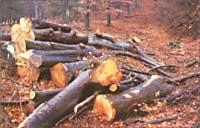
The beech, seen from above, takes the form of a uniform carpet, leaving the passage with leaves very unclear. Therefore, in the heart of these beech trees the number of plant species is relatively small, only some that are well adapted to these conditions
However, some plants, before leaves come out, adapt their biological cycle by taking advantage of the luminosity.
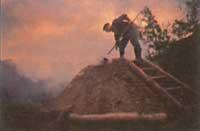

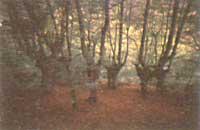
In winter, without leaves, sadness prevails in the solitude of the jungle. In spring, when outbreaks come out, joy spreads everywhere. In summer, the forest mosaic is completely complete, thanking the pleasant freshness of the forest interior. In autumn it is paradise of paintings, romantics.
In the beech, the epiphytic plants seek their place in the trunks and branches of these trees, with abundance of mosses, lichens and ferns. On the other hand, mushrooms and mushrooms are typical forest species in suitable times.
Beech fauna
If the structure of the beech conditioned the number of plant species, we could say that the same happens with the fauna. Since beech production is very variable and the number of animals tends to pursue this food, the abundance of these species is highly conditioned. On the other hand, the low price exploitation of the forest does not benefit the development of the fauna and, in addition, the tendency to remove the old logs excavated from the forest makes the fauna not fit well. The occasional abandonment of these logs in the forests would be very important, since many animals use it as a site.
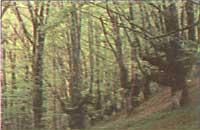


In the animal community we can cite especially amphibians, birds and mammals. As is known, amphibians need moisture, keeping the skin always wet. In general, beech offers moisture, so some amphibians have found in these forests an appropriate place to live. We can find the arrabio (Salamandra salamandra), the pale triton (Triturus helveticus), the alpine triton (Triturus alpestris), the common txantxiku (Alyobstetrictes), the common toad (Bufo bufo) and the red frog (Rana temporaria).
Reptiles also colonize these beech trees, being the most representative species of this group the life snake (Zootoea vivipara). However, in the beech there are remarkable species such as the mural lizard (Podareis muralis), the green lizard (Lacerta viridis), the cirauna (Anguis fragilis), the aspis viper (Vipera aspis) and the Seoane viper (Vipera seoanei).
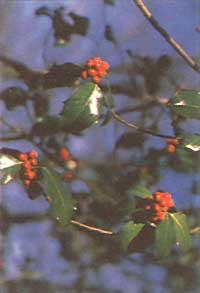
Although not many bird species (max. 50 birds/10 ha) appears an interesting number of species such as the calf (Scopolax rusticola), the common falcon (Buteo buteo buteo), the common trocito (Caprimulgus europaeus), the robin (Erithacus rubecula), the acarino (Turdus viscivorus), the parlanco Vaca, paiño, pauquino.
Small mammals also appear in the beech: clayey satitsu (Sorex araneus), satitsu txikia (Sorex minutus), red topillo (Clethrionomys glareolus) and grey liron (Glis glis). Despite the scarcity of large mammals, in large well-preserved forests, wild boar (Sus sorofa) is a typical species, although occasionally also appear wild cat (Felix silvestris), fox (Vulpes vulpes vulpes) and hare (Lepus capensis). It also highlights the deer (Cervus elaphus). Formerly it was widespread in the Basque Country, and went to disappear with hunting. Efforts are currently being made, as far as possible, to return to the previous situation. The results obtained so far have been optimistic, especially in the beech forests of Irati and Gorbeia.
Ecological value of beech
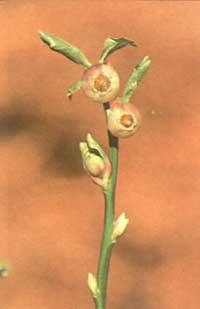
Although the aesthetic-landscape value of beech is high, it is noteworthy its defensive attitude in the different natural cycles. It produces rich humus by exhaustive control of runoff waters, protects the soil from erosion and compensates for the mass of water filtered by the lower layers by perspiration of a large amount of precipitation. On many occasions, these forests are also used as amusement parks, highlighting their educational possibilities.
Beech in education
In the beech it is not a mere sum of trees, but the structure that makes it is a consequence of the continuous relations between all its elements. In these ecosystems, therefore, we can analyze many of the relationships that occur in nature. In addition, being a typical element of our people, both from the landscape point of view as usual and use, should appear in the curricula of our school courses, in which we should encourage experimentation. We must not forget that Primary Education students have begun to learn their environment and their socio-cultural roots.
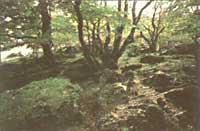
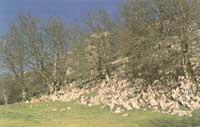
It would not be enough to teach it in a theoretical way or method in our schools, since, like in other ecosystems, the aforementioned experimentation is very enriching. In this way, the values that students can develop with respect to the forest would be ethically strengthened, that is, respect for the forest would be encouraged, the improvement of the forest and its correct use according to the law of nature.
The consideration of beech as a didactic unit would generate a positive attitude towards the environment, both for the study of the different ecosystems existing in our territory and for the full reception of our planet. Therefore, our public institutions should use the following criteria when celebrating the Zuhaitz Eguna, since specific actions are of little value.

However, for example, consideration of beech as a teaching unit may have the following objectives:
General objective
Know our environment, in our case the beech.
Specific objectives
- Knowledge of the history and general uses of beech.
- Reinforce the tendency to know and classify the tree itself and the different plants that appear in it, enhancing the ability to use guides and other sources.
- Understanding the main relationships between vegetation and soil.
- To know the fauna of the beech, analyzing more the dynamics of some typical species.
- Differentiate well the differences between natural and artificial forest.
- Study of the relationships between living beings within the beech.
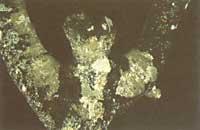
Professionals will not have difficulty writing more or less concrete objectives, or creating different actions within the beech. From these lines, we would like to highlight the great weight that education has to know, transmit and ultimately love our culture and ecological wealth, and that educators must show our attitude of attention and impulse so that we can carry out all these objectives.
Anonymous said... PAGADIAN!

After crossing the village, I followed the road to the mountain. Upon reaching this old hamlet, a noisy dog informs the population of the arrival, although no one has paid attention.
Near there the road is divided into two and I have taken the wildest. I feel the moving stones under my feet. The river will not be far away. I don't know, but I can hear the breath of water. The feet lift us up. The harmonious music of the leaves is mixing with the beat of my heart, immersing me in an unstoppable whirlwind. Southern wind, crazy wind? The hot wind blows hard on this slope. As the road narrows, the steps soften, highlighting the sweetness of the red tapestry as a caress of love.

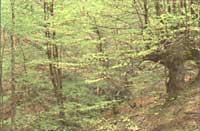
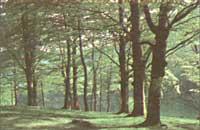

I have seen the first beeches around some lonely chestnut trees. The path just looks like a path. I would like to see the feet of the first man who passed here, be his smell, enjoy his ear, what he felt when he heard the interrupted singing of both txontas. The beech grows narrower, deeper and deeper. I don't hear the old water song. I barely see the sun. Its rays are reflected in the leaves of the beeches and, except in some small corners, its brightness is illuminated with sadness as a loving taste.
Looking up, I know nothing more than a leaf, in which parts of starry sky are interspersed. Some fearful bird equating silence. Butterflies protruding from invisible slits. Some mushroom at the foot of the trunk. Forest pattern singing. No wind. I have reached the heart of the paradise of naturalists.
Hidden lovers, silver treasures of reflections, cradle of dreams. He sees you in the center of the beech. Among all your memories, your clear eyes, your anger, your soft hands. Witness your love, a dream. Just as the beech rises, you have gotten very big in my heart. Silent sensations, dazzled in loving dizziness, emotion of the fereca. Hayedo!
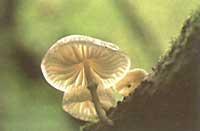
Shy Oskorri is the prelude to the arrival of the moon.
In the fury of joy, it has taken my dream!
Amets, amets, amets,...
HayedoForest of oak and husbands
alpetarrUhandre palmate Uhandre marmoluRed
wild frog
(Robledal)
21,411,7
21.5
Buletina
Bidali zure helbide elektronikoa eta jaso asteroko buletina zure sarrera-ontzian










